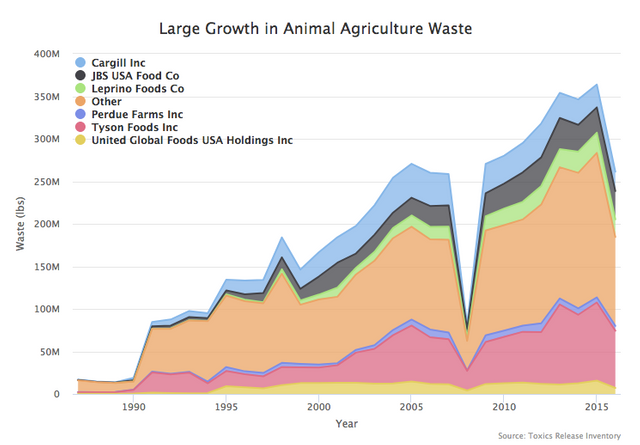Big Increases in Animal Agriculture Waste
Visualizing industrialization by measuring poop.
Animal agriculture is increasingly industrial, as demonstrated by a decreasing amount of small farms, and a steady increase of the percentage of animals on factory farms.
Another way to measure the industrialization of animal agriculture is to chart the waste produced by industry facilities. Using data from the Environmental Protection Agency's Toxics Release Inventory (TRI) Program, I charted the past 30 years in animal agriculture waste. These estimates measure the amount of waste that has been released or treated at the facility where it was created. In animal agriculture, this often involves spraying waste or depositing it in a septic pit.

Waste produced by industrial animal agriculture facilities has increased in the past 30 years. This trend has taken place despite the demand and consumption of meat having seen a reasonable decline during this time period. It is also noteworthy that while this chart represents over 450 companies, just 6 of them consistently create as much waste as the other several hundred.
I am going to look deeper into what happened with the 2008 data, because as of now I cannot find an explanation for this very strange blip, which may be too inconsistent to reflect genuine information. Similarly, since the change between 2015 and 2016 in steeper than the difference between any other two years, I do not believe that all Toxics Release data from industries in 2016 has been made available yet.
This increase in waste production and industrialization is concerning due to the industry practices of large-scale operations that abuse animals, harm workers, threaten public health, damage the health of poorer communities, and heavily contribute to climate change. There is too much waste, and not enough waste management.
The code used to make these graphs is on GitHub. Content cross-posted on my personal website.

A sort of irony of this entire system is if it was encouraged to use old farming practices of open larger spaces for animals to be reared, it would result in higher costs of meat, BUT then we would also eat a normal amount of healthy meat which would aid us all in weight control as well as general health. I have a feeling there are too many different corporate entities that would not want such changes. We live in odd times.
You're on the nose about corporate entities! In the US, animal agriculture groups spend tons of money on lobbying in response to decreased animal product consumption, and the meat industry also wields an immense advertising budget.
This post mistakenly measured waste produced by slaughterhouses and meat processing facilities rather than the livestock farms themselves. Here is an updated version of this post and code that measures livestock as intended, and contains additional analysis.